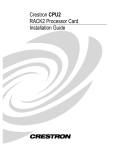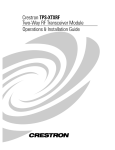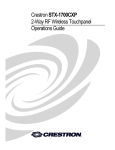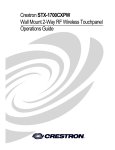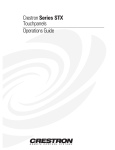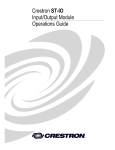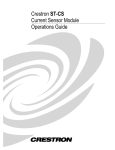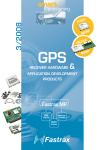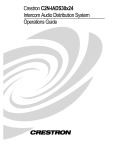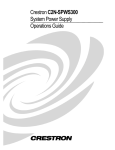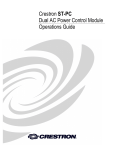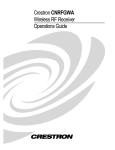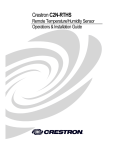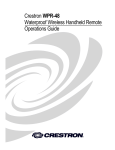Download Crestron TPS-RFGWX Specifications
Transcript
Crestron TPS-RFGWX Two-Way RF Transceiver Operations Guide This document was prepared and written by the Technical Documentation department at: Crestron Electronics, Inc. 15 Volvo Drive Rockleigh, NJ 07647 1-888-CRESTRON All brand names, product names and trademarks are the property of their respective owners. ©2003 Crestron Electronics, Inc. Crestron TPS-RFGWX Two-Way RF Transceiver Contents Two-Way RF Transceiver: TPS-RFGWX.......................................................1 Introduction ............................................................................................................................... 1 Functions and Features ................................................................................................ 1 Specifications .............................................................................................................. 3 Physical Description.................................................................................................... 4 Industry Compliance ................................................................................................... 7 Setup .......................................................................................................................................... 8 Network Wiring........................................................................................................... 8 Identity Codes.............................................................................................................. 8 Hardware Hookup ..................................................................................................... 11 Programming Software ............................................................................................................ 12 Uploading and Upgrading........................................................................................................ 12 Communication Settings ........................................................................................... 13 Firmware Upgrade..................................................................................................... 15 Problem Solving ...................................................................................................................... 17 Troubleshooting......................................................................................................... 17 Further Inquiries ........................................................................................................ 19 Future Updates .......................................................................................................... 19 Appendix A: Optimum RF Reception Guidelines .................................................................. 20 Minimize Interference ............................................................................................... 20 Gateway Placement ................................................................................................... 20 Antenna Orientation .................................................................................................. 20 Return and Warranty Policies .................................................................................................. 22 Merchandise Returns / Repair Service ...................................................................... 22 CRESTRON Limited Warranty................................................................................. 22 Operations Guide - DOC. 5847A Contents • i Crestron TPS-RFGWX Two-Way RF Transceiver Two-Way RF Transceiver: TPS-RFGWX Introduction Functions and Features The TPS-RFGWX is a two-way radio frequency (RF) gateway/transceiver that utilizes 2.4 GHz spread spectrum technology to communicate with Crestron IsysTM tilt touchpanels equipped with the optional TPS-XTXRF Two-Way RF Transceiver Module, and other similarly equipped Crestron touchpanels such as the STX1700CXP. NOTE: Throughout this operations guide, an IsysTM tilt touchpanel equipped with the optional TPS-XTXRF Two-Way RF Transceiver Module is referred to as TPS-XTXRF equipped touchpanel or touchpanel, except where noted. For related information, consult the TPS-XTXRF Operations & Installation Guide (DOC. 5844). Similarly, the STX-1700CXP 2-Way RF Wireless Touchpanel is also referred to as touchpanel. For related information, consult its operations guide (DOC. 6144). The latest versions of the guides can be obtained from the Downloads | Product Manuals section of the Crestron website (www.crestron.com). The TPS-RFGWX receives RF signals from one or more touchpanels (sold separately) and translates the signals into commands for transmission over the Crestron control system (Cresnet system). Feedback signals from the Cresnet system are transmitted from the TPS-RFGWX to the touchpanel(s) for real-time confirmation of commands. Up to 15 touchpanels can communicate with one TPSRFGWX and, if more touchpanels are needed, more TPS-RFGWXs (up to 16) may be added to the system. Functional Summary • • • Operations Guide - DOC. 5847A Two-way RF transceiver/gateway − 2.4 GHz spread-spectrum technology − Range from 3 feet to maximum between 100 to 200 feet Communicates with up to 15 touchpanels “Wi-Fi” friendly operating frequency selection to avoid interference Two-Way RF Transceiver: TPS-RFGWX • 1 Two-Way RF Transceiver Crestron TPS-RFGWX The TPS-RFGWX gateway utilizes spread spectrum technology. Spread spectrum eliminates the risk of signal “drop-out” by automatically cycling through several frequencies. The RF signals can travel from a minimum of three feet up to a maximum between 100 - 200 feet indoors; the range is dependent on construction of the building, obstructions, and RF interference from other devices. The location of the TPS-RFGWX and the orientation of the antenna are also important factors in the RF performance. When an STX-1700CXP or TPS-XTXRF-equipped touchpanel is powered up, it rapidly scans the assigned frequency band for the synchronizing signal. The touchpanel may have to scan 75 different frequencies and take several seconds to synchronize with the TPS-RFGWX. Once the touchpanel is synchronized, it requests registration from the TPS-RFGWX and is then ready to operate. Typical power-up time for the touchpanel to establish communication with the TPS-RFGWX is three to five seconds. However, it may take up to 20 seconds depending on the environment and radio traffic in the 2.4 GHz spectrum. As more touchpanels are added to the system, the time required to synchronize and communicate data is extended. If the touchpanel loses communication with the TPS-RFGWX (i.e., out of range, battery depleted), the gateway does not store button presses or commands. When the TPS-RFGWX loses communication with the touchpanel, the signal LED may remain lit for 10 seconds before extinguishing. If the TPS-RFGWX loses operating power, 15 to 20 seconds are required to re-establish the communications with the touchpanel after power is restored. The amount of time depends upon the environment and radio traffic in the 2.4 GHz Spectrum. Wi-Fi Technology Wi-Fi (wireless fidelity) is the common term for high-frequency wireless local area network (WLAN) technology that is gaining acceptance as an alternative to a wired LAN in commercial as well as home network configurations. Wi-Fi is detailed in the 802.11b specification from the Institute of Electrical and Electronics Engineers (IEEE) and is part of a series of wireless specifications together with 802.11, 802.11a, and 802.11g. The TPS-RFGWX gateway is not “Wi-Fi compatible.” It does not comply with the 802.11 specifications, nor can it communicate with 802.11 devices. It is, however, considered “Wi-Fi friendly,” since you can select a communication band (frequency range) that will avoid interference with 802.11 devices. The gateway’s transceiver (as well as the touchpanel’s) allows you to select one of ten possible bands (0 through 9) for communication. The bands define specific frequency ranges within the 2.4 GHz Spectrum. The default band (Band 0) covers almost the entire spectrum and is, therefore, not Wi-Fi friendly. The nine additional bands define narrower ranges, leaving the rest of the frequency spectrum available for other RF devices, thus making it possible to avoid interference. Refer to “Channel ID, Band, and Power Setting” on page 9 for details. As you configure the gateway for operation, you select a Channel ID to identify the gateway for the touchpanel(s) communicating with it. Up to 15 touchpanels can communicate with each gateway; up to 16 gateways can be included in one SIMPL program. You then select one of the ten frequency bands. Selection of a band is based on a number of factors, most importantly the need to avoid interference with nearby RF devices, and compliance with local communication laws. Crestron recommends using Bands 5 (USA comp 1) through 9 (USA comp 5) within the US. Bands 1 through 4 (France, Spain, Japan, and Canada) are intended for use in Cresnet systems outside the US. 2 • Two-Way RF Transceiver: TPS-RFGWX Operations Guide - DOC. 5847A Crestron TPS-RFGWX Two-Way RF Transceiver If you have two or more Crestron wireless RF devices in the Cresnet system, they should all be set to the same band. If your system includes non-Crestron RF devices, set the Crestron RF devices to a different band than the non-Crestron devices to minimize the possibility of interference between them. Touchpanel Compatibility The ability to select frequency bands makes it possible for the TPS-RFGWX gateway to communicate with touchpanels that are Wi-Fi friendly, such as the STX1700CXP, as well as those that are not. Gateways that are Wi-Fi-friendly (include band selection) have product labels that include a seven-digit number beginning with 600 (e.g., 6002104). Product labels on earlier models of the gateway (fixed band; not Wi-Fi friendly) included seven-digit alphanumeric codes beginning with ZA (e.g., ZA11308). Similarly, Wi-Fi friendly gateways can communicate with touchpanels that are not so enabled as well as those that are. In either case, in order to communicate, the gateway and touchpanel must be set to the same band and have identical identity code settings (refer to “Identity Codes” on page 8 for details). Specifications The table below is a summary of specifications for the TPS-RFGWX. Specifications of the TPS-RFGWX SPECIFICATION DETAILS Power Requirements 3 Watts (24VDC @ 0.125A) Communications Bidirectional Spread Spectrum 2.4 GHz (2400 to 2483 MHz), transmit power 100 mW Operating Ranges¹ Minimum Distance 3 ft Maximum Distance Indoors 100 ft to 200 ft Maximum Distance Outdoors RF Specifications 1000 ft Bidirectional Spread Spectrum 2.4 GHz (range approximately 100 - 200 feet). Requires one TPS-RFGWX transceiver per 15 touchpanels. Default Net ID 52 Default Channel ID 0 (Identifies the RF gateway to the touchpanels used for communication) Default RF Band Band 0 (USA original) Ten frequency bands (ranges) available for selection. Control System Update Files 2, 3 2-Series Control System Update Version C2-3.044.CUZ or later CEN/CN-TVAV Update File Version 5.12.63V.UPZ or later CNMSX-AV/Pro Update File Version 5.14.02X.UPZ or later CNRACKX/-DP Update File Version 5.14.02W.UPZ or later Acceptable file extensions .csf TPS-RFGWX.vx.xxx.x.csf (transceiver firmware) TPS-RFGWX firmware Version 2.15 or later Dimensions Width: 1.70 in (4.32 cm) Height: 7.07 in (17.95 cm) Depth: 6.32 in (16.06 cm) Weight 1 Operations Guide - DOC. 5847A 2.38 lb (0.93 kg) The location of the TPS-RFGWX and the orientation of the antenna are important factors in the RF performance. With the unit located outside of any metal enclosures, the antenna is adjusted to achieve the best range. The range is dependent on its placement and the building in which it is used. The construction of the building, obstructions, and RF interference from other devices are factors Two-Way RF Transceiver: TPS-RFGWX • 3 Two-Way RF Transceiver Crestron TPS-RFGWX determining the effective range of the unit. To prevent unit-to-unit RF interference, multiple gateway/transceivers operating at the same frequencies (TPS-RFGWXs and/or Crestron CNRFGWXs) should not be installed within 3-5 feet of each other. 2 The latest versions can be obtained from the Downloads | Software Updates section of the Crestron website (www.crestron.com). Refer to NOTE after last footnote. 3 Crestron 2-Series control systems include the AV2, AV2 with Card Cage, CP2, CP2E, PAC2, MC2W, MC2E, MP2, MP2E, PRO2, and RACK2. NOTE: Crestron software and any files on the website are for Authorized Crestron dealers and Crestron Authorized Independent Programmers (CAIP) only. New users may be required to register to obtain access to certain areas of the site (including the FTP site). Physical Description The TPS-RFGWX, shown below, is housed in a black enclosure with labeling on the front and rear panels. Five light-emitting diodes (LEDs) on the front of the unit indicate the unit’s operating status. The RF antenna is not shown for clarity. All other connections are made on the back of the unit; a 4-pin connector plug is provided to connect to other Cresnet system devices. There are four rubber feet on the base of the unit for stability and to prevent slippage. Physical View of TPS-RFGWX 4 • Two-Way RF Transceiver: TPS-RFGWX Operations Guide - DOC. 5847A Crestron TPS-RFGWX Two-Way RF Transceiver TPS-RFGWX Detail Views 7.07 in (17.95 cm) NET NET NET 24 Y Z G CRESTRON ELECTRONICS INC. ROCKLEIGH, N.J. 07647 USA 6.32 in (16.06 cm) RF GATEWAY - 2 WAY RF PWR NET SIG Rx CRESTRON ANTENNA Tx 1.70 in (4.32 cm) TPS-RFGWX TPS-RFGWX Ports The rear panel of the TPS-RFGWX contains three labeled Cresnet ports. Refer to the diagrams and descriptions that follow. NET (Modular Cresnet) These two 6-pin, 6-position RJ11 modular jacks are used to connect the TPS-RFGWX to modular devices in the Cresnet system. Two NET ports are available so that network units can be daisy-chained together. RJ11 Pinout Signals Pin # Operations Guide - DOC. 5847A Signal 1 24 VDC 2 24 VDC 3 Y 4 Z 5 GND 6 GND Two-Way RF Transceiver: TPS-RFGWX • 5 Two-Way RF Transceiver Crestron TPS-RFGWX NOTE: Most 6-conductor telephone cables are wired in a crisscross fashion and are not compatible with Crestron equipment. NOTE: All NET connectors, the two modular and the four-wire, can be used simultaneously. NET 24 Y Z G NET (Four-Wire Cresnet) This 4-pin connector is used to connect the TPS-RFGWX to other four-wire devices in the Cresnet system. TPS-RFGWX Indicators There are five LED indicators located on the front panel of the TPS-RFGWX. Refer to the diagram and descriptions that begin below. The front panel also has a connector where the supplied antenna is attached. The antenna transmits and receives the touchpanel RF signals. TPS-RFGWX Indicators RF GATEWAY - 2 WAY RF PWR NET CRESTRON SIG Rx ANTENNA Tx TPS-RFGWX PWR This LED illuminates when Cresnet power is supplied to the TPS-RFGWX. NET This LED illuminates when communication with the Cresnet system and the TPSRFGWX is established (the unit is polled on the network). Illumination indicates that the SIMPL Windows program currently loaded has a network device defined at the same NET ID code as the TPS-RFGWX. RF These three LEDs monitor the RF communications of the TPS-RFGWX. The SIG LED illuminates when the TPS-RFGWX is in RF communication with a touchpanel. This LED also flashes 20 times to indicate that the TPS-RFGWX has rebooted. The Rx LED illuminates when a command is received from a touchpanel and Tx illuminates when feedback is transmitted to a touchpanel. If the touchpanel goes out of range, the Tx LED will flash every four to five seconds for approximately 30 seconds and then stops flashing (the unit stops transmitting if the touchpanel does not come into range in the allotted time). If the touchpanel comes into range before the TPS-RFGWX stops transmitting, the touchpanel display reverts to whatever screen the control system has active. If the touchpanel comes into range after the TPSRFGWX stops transmitting, the user must touch the touchpanel screen to activate the gateway and leave the out of range screen. Any messages sent to the touchpanel while it was out of range will be sent after normal communication resumes. 6 • Two-Way RF Transceiver: TPS-RFGWX Operations Guide - DOC. 5847A Crestron TPS-RFGWX Two-Way RF Transceiver Industry Compliance As of the date of manufacture, this unit has been tested and found to comply with specifications for CE marking and standards per EMC and Radio Communications Compliance Labeling (N11785). NOTE: This device complies with part 15 of the FCC rules. Operation is subject to the following two conditions: (1) this device may not cause harmful interference, and (2) this device must accept any interference received, including interference that may cause undesired operation. NOTE: This equipment has been tested and found to comply with the limits for a Class B digital device, pursuant to part 15 of the FCC Rules. These limits are designed to provide reasonable protection against harmful interference in a residential installation. The equipment generates, uses and can radiate radio frequency energy and, if not installed and used in accordance with the instructions, may cause harmful interference to radio communications. However, there is no guarantee that interference will not occur in a particular installation. If this equipment does cause harmful interference to radio or television reception, which can determined by turning the equipment off and on, the user is encouraged to try to correct the interference by one or more of the following measures: Operations Guide - DOC. 5847A ■ Reorient or relocate the receiving antenna. ■ Increase the separation between the equipment and transceiver. ■ Connect the equipment into an outlet on a circuit different from that to which the transceiver is connected. ■ Consult the dealer or an experienced radio/TV technician for help. Two-Way RF Transceiver: TPS-RFGWX • 7 Two-Way RF Transceiver Crestron TPS-RFGWX Setup Network Wiring CAUTION: Use only Crestron power supplies for Crestron equipment. Failure to do so could cause equipment damage or void the Crestron warranty. NOTE: When installing network wiring, refer to the latest revision of the wiring diagram(s) appropriate for your specific system configuration, available from the Downloads | Product Manuals | Wiring Diagrams section of the Crestron website (www.crestron.com). When calculating the wire gauge for a network run, the length of the run and the power factor (power usage in watts) of each network unit must be taken into consideration. If multiple network units are to be daisy-chained, the power factors of each unit must be added to determine the power factor of the entire chain. The length of the run in feet and the power factor of the run (in watts) should then be used in the following resistance equation. R < 40,000 L x PF Where: R = Resistance (refer to table below). L = Length of run (or chain) in feet. PF = Power factor of entire run (or chain). The required wire gauge should be chosen such that the resistance value is less than the value calculated in the resistance equation. Refer to the table after this paragraph. Wire Gauge Values RESISTANCE (R) WIRE GAUGE 4 16 6 18 10 20 15 22 13 Doubled CAT5 8.7 Tripled CAT5 NOTE: All network wiring must consist of two twisted-pairs. One twisted pair is the +24V conductor and the GND conductor; the other twisted pair is the Y conductor and the Z conductor. NOTE: When daisy-chaining Cresnet units, strip the ends of the wires carefully to avoid nicking the conductors. Twist together the ends of the wires that share a pin on the network connector, and tin the twisted connection. Apply solder only to the ends of the twisted wires. Avoid tinning too far up the wires or the end becomes brittle. Insert the tinned connection into the Cresnet connector and tighten the retaining screw. Repeat the procedure for the other three network conductors. Identity Codes The TPS-RFGWX gateway/transceiver uses three forms of identification for recognition within a Cresnet system and to communicate with a TPS-XTXRF or STX-1700CXP touchpanel: Cresnet identity (NET ID), channel ID, and band. The 8 • Two-Way RF Transceiver: TPS-RFGWX Operations Guide - DOC. 5847A Crestron TPS-RFGWX Two-Way RF Transceiver NET ID assignment must match the assignment made in the SIMPL Windows project. In addition, a Low Power Mode setting lets you reduce the transmission power to reduce or eliminate interference with other RF devices communicating with or near the Cresnet system. NET ID For a definition of Viewport, refer to the Note on page 12 Every piece of equipment and user interface within the Cresnet system requires a unique NET ID. These codes are two-digit hexadecimal numbers from 03 to FE. The NET ID of the unit must match the NET ID specified in the SIMPL Windows program. The NET ID of the TPS-RFGWX is factory set to 52. The NET IDs of multiple TPS-RFGWXs must all be unique and changed from a PC via the Crestron Viewport. To set or change the NET ID of the TPS-RFGWX, complete the following steps. 1. Attach only one TPS-RFGWX to the control system (verify that the software is running). 2. Open the Crestron Viewport (Version 3.53). Either launch the stand-alone version of Viewport, or start SIMPL Windows or VT Pro-e, and from the menu bar, select Tools | Viewport. 3. From the Viewport menu, select Functions | Set Network ID. The software checks the baud rate and then opens the “Set Network ID” window. 4. In the “Set Network ID” window, select the TPS-RFGWX from the Current Network Devices text window. 5. From the Choose the new network ID for the selected device (Hex): text box, select the new Net ID for the TPS-RFGWX. 6. Click Set ID to initiate the change. This will display the “ID command has been sent” window. 7. In the “Command Complete” window, click OK. 8. In the Current Network Devices text window, verify the new NET ID code. 9. In the “Set Network ID” window, click Close. NOTE: The new NET ID code may also be verified by selecting Diagnostic | Report Network Devices in the Viewport. 10. Attach each TPS-RFGWX to be added to the Cresnet system individually and repeat this procedure as needed. Channel ID, Band, and Power Setting Each gateway communicating with a touchpanel must have a channel ID and band assignment that matches the RF channel and band assignment of the touchpanel. There are 16 possible channels ranging from 0 to F (hexadecimal number) and the channel assigned to each touchpanel must be unique. Similarly, there are 10 possible bands that can be selected, and the selection made for the touchpanel and the gateway must match. Also, if two or more gateways are operating in close proximity and experiencing interference problems, you can select the Low Power Mode to reduce signal strength, which may eliminate the interference. Operations Guide - DOC. 5847A Two-Way RF Transceiver: TPS-RFGWX • 9 Two-Way RF Transceiver Crestron TPS-RFGWX These settings are made from a PC via the Crestron Viewport. Complete the following steps: 1. Open the Crestron Viewport. (Version 3.53). Either launch the stand-alone version of Viewport, or start SIMPL Windows and from the menu bar, select Tools | Viewport. 2. From the Viewport menu, select Functions | Set RFGWX Channel. The software checks the baud rate and then opens the “RFGWX Channel ID” window as shown below. “RFGWX Channel ID” Window 3. In the top portion of the “RFGWX Channel ID” window, select the network ID of the gateway that requires the RF channel to be set. 4. In the middle portion of the window, select the desired channel ID for each gateway (up to 16) and all touchpanels (up to 15) associated with that gateway. In the bottom portion of the window, select the desired band for the gateway. The choices correspond with the band names shown in the table on the next page. The table shows the 802.11b channels within each band that are occupied by the STX-1700CXP. Selection of a band is based on a number of factors, including the need to avoid interference with nearby RF devices, and compliance with local communication laws. In the US, Crestron recommends using Bands 5 (USA comp 1) through 9 (USA comp 5). Bands 1 through 4 (France, Spain, Japan, and Canada) are intended for use in Cresnet systems outside the US. The default setting is Band 0, USA (original), which is not Wi-Fi friendly. Note that at this setting, the gateway can communicate with the touchpanels whether they are Wi-Fi friendly or not, since Band 0 is the default setting for both versions. 10 • Two-Way RF Transceiver: TPS-RFGWX Operations Guide - DOC. 5847A Crestron TPS-RFGWX Two-Way RF Transceiver Band # 0 1 2 3 4 5 6 7 8 9 Freq. Range (MHz) 2400-2474 2448-2474 2448-2474 2471-2497 2452-2477 2400-2425 2409-2435 2419-2445 2430-2455 2440-2465 Occupied 802.11b Channels Band Name USA (original) France Spain Japan Canada USA (comp 1) USA (comp 2) USA (comp 3) USA (comp 4) USA (comp 5) 1 • 2 • 3 • 4 • 5 • • • • • • • • • • • • • • • • • • • 6 • • • • • 7 • • • 8 • • • • • 9 10 11 12 13 14 • • • • • • • • • • • • • • • • • • • • • • • • • • • • • • • • • • • • • • • • In the table, a bullet (•) indicates channels that are used by the STX-1700CXP. The unmarked channels can be used by other devices communicating near the Cresnet system, thus minimizing interference. 5. Select or deselect the Low Power Mode check box as needed. NOTE: The band setting of the TPS-RFGWX and the touchpanel must match in order for them to communicate. 6. From the Viewport menu, select Diagnostics | Report Network Devices and verify that the unit has the desired channel ID. 7. Repeat this procedure for each TPS-RFGWX to be added to the Cresnet system. Hardware Hookup Refer to the hookup diagram below, which shows the TPS-RFGWX connections to the Cresnet system. Complete the connections in any order. NOTE: To prevent unit-to-unit RF interference, multiple gateway/transceivers operating at the same frequencies (TPS-RFGWXs and/or Crestron CNRFGWXs) should not be installed within three to five feet of each other. Refer to “Specifications” of each operations guide for the communications frequency of each device. NOTE: Refer to “Network Wiring” on page 8 when making connections to the ports labeled NET. Cresnet System Hookup Connections for TPS-RFGWX TO ANY STS OR CRESNET NETWORK DEVICES FOR NORMAL OPERATION OR FOR PROGRAMMING NET NET NET 24 Y Z G CRESTRON ELECTRONICS INC. ROCKLEIGH, N.J. 07647 USA TO CONTROL SYSTEM FOR NORMAL OPERATION OR PROGRAMMING Operations Guide - DOC. 5847A Two-Way RF Transceiver: TPS-RFGWX • 11 Two-Way RF Transceiver Crestron TPS-RFGWX Programming Software The TPS-RFGWX provides two-way wireless RF communication between a Crestron control system and a Crestron IsysTM tilt touchpanel equipped with the optional TPS-XTXRF Two-Way RF Transceiver Module or other similarly-equipped Crestron touchpanels, such as the STX-1700CXP. Have a comment about Crestron software? Although the device itself is not programmable, you can create a program that includes a TPS-RFGWX using the Crestron programming tool SIMPL Windows. Direct software related suggestions and/or complaints to Crestron via email ([email protected]). Do not forward any queries to this address. Instead refer to “Further Inquiries” on page 19 for assistance. SIMPL (Symbol Intensive Master Programming Language) is an easy-to-use programming language that is completely integrated and compatible with all Crestron system hardware. The objects that are used in SIMPL are called symbols. SIMPL Windows offers drag and drop functionality in a familiar Windows® environment. SIMPL Windows is Crestron's software for programming Crestron control systems. It provides a well-designed graphical environment with a number of workspaces (i.e., windows) in which a programmer can select, configure, program, test, and monitor a Crestron control system. To create a program with a TPS-RFGWX, consult the TPS-XTXRF Operations & Installation Guide (Doc. 5844) or the STX-1700CXP 2-Way RF Wireless Touchpanel Operations Guide (Doc. 6144). The latest versions of these guides can be obtained from the Downloads | Product Manuals section of the Crestron website (www.crestron.com). Example Program For an example program including the TPS-RFGWX, refer to the program for the STX-1700CXP which is available from the Downloads page (EXAMPLES Library) of Crestron’s website (ftp://ftp.crestron.com). Search for STX1700CXP.SMW. Uploading and Upgrading Assuming a PC is properly connected to the entire system, Crestron programming software allows the programmer to upload programs and projects after their development to the system and network devices. However, there are times when the files for the program and projects are compiled and not uploaded. Instead, compiled files may be distributed from programmers to installers, from Crestron to dealers, etc. Even firmware upgrades are available from the Crestron website as new features are developed after product releases. In those instances, one has the option to upload via the programming software or to upload and upgrade via the Crestron Viewport. NOTE: The Crestron Viewport utility accomplishes multiple system tasks, primarily via an RS-232 or TCP/IP connection between the control system and a PC. It is used to observe system processes, upload new operating systems and firmware, change system and network parameters, and communicate with network device consoles and touchpanels, among many other tasks. Viewport can also function as a terminal emulator for generic file transfer. All of these functions are accessed through the commands and options in the Viewport menus. Therefore, for its effectiveness as a support and diagnostic tool, the Crestron Viewport may be preferred over development tools when uploading programs and projects. The following sections define how one would upgrade the firmware of the TPSRFGWX. However, before attempting to upgrade, it is necessary to establish communications. 12 • Two-Way RF Transceiver: TPS-RFGWX Operations Guide - DOC. 5847A Crestron TPS-RFGWX Two-Way RF Transceiver Communication Settings NOTE: For laptops and other PCs without a built-in RS-232 port, Crestron recommends the use of PCMCIA cards, rather than USB-to-serial adapters. If a USB-to-serial adapter must be used, Crestron has tested the following devices with good results: Belkin (large model) F5U103 I/O Gear GUC232A Keyspan USA-19QW Other models, even from the same manufacturer, may not yield the same results. The procedure in this section provides details for RS-232 communication between the PC and the control system. If TCP/IP communication is preferred, consult the latest version of the Crestron e-Control Reference Guide (Doc. 6052) or the respective Operations Guide for the control system. These documents are available from the Downloads | Product Manuals section of the Crestron website (www.crestron.com). Refer to the figure below for a typical connection diagram when uploading files. Note: Use a standard DB9 male to female “straight-through” cable. Typical Connection Diagram when Establishing Communication Operations Guide - DOC. 5847A Two-Way RF Transceiver: TPS-RFGWX • 13 Two-Way RF Transceiver Crestron TPS-RFGWX 1. Open the Crestron Viewport. Either launch the stand-alone version of Viewport, or start SIMPL Windows and from the menu bar, select Tools | Viewport. 2. Refer to the figure after this step. From the Viewport menu, select Setup | Communications settings (alternatively, press Alt+D) to open the “Port Settings” window. Setup | Communications Settings Command 3. Select RS-232 as the connection type. Verify that an available COM port (COM 1 is shown after this step) is selected, Verify that the baud rate is set to 115200 (PRO 2 default), the parity is None, the data bits is Eight, the stop bits is One, XON/XOFF is not selected, and RTS/CTS is selected as shown after this step. Click the OK button to save the settings and close the window. “Port Settings” Window 14 • Two-Way RF Transceiver: TPS-RFGWX Operations Guide - DOC. 5847A Crestron TPS-RFGWX Two-Way RF Transceiver NOTE: The parameters shown in the illustration above are the port settings for a 2Series control system. Consult the Operations Guide for the control system being used for exact parameter selection. 4. To verify communication, select Diagnostics | Establish Communications (Find Rack). This should display a window that gives the COM port and baud rate. If communication cannot be established, refer to the “Troubleshooting Communications” section in the respective Operations Guide for the control system. Firmware Upgrade A firmware upgrade file has the extension .csf. To take advantage of all the TPS-RFGWX features, it is important that the unit contains the latest firmware available. Please check the Crestron website (http://www.crestron.com/downloads/software_updates.asp) for the latest version of firmware. Not every product has a firmware upgrade, but as Crestron improves functions, adds new features, and extends the capabilities of its products, firmware upgrades are posted. To upgrade the firmware, complete the following steps. 1. Make sure that “Communication Settings,” which begins on page 13, has been performed. 2. As shown after this step, select File Transfer | Load Network Device from the Viewport menu bar. File Transfer | Load Network Device Command Operations Guide - DOC. 5847A Two-Way RF Transceiver: TPS-RFGWX • 15 Two-Way RF Transceiver Crestron TPS-RFGWX 5. To determine the equipment on the network, select Diagnostics | Report Network Devices from the Viewport menu bar. The screen lists the equipment, as shown in the following simplified example, and shows the TPS-RFGWX’s RF ID, its firmware version, the RF channel setting, the power setting, and the band setting. Example Equipment Listing Report 6. As shown in the “Select Network ID” window, select the NET ID of the TPS-RFGWX, and then click OK. The “Open” window appears (refer to the graphics below). “Select Network ID” Window NOTE: When transferring a Cresnet file (touchpanel project/ firmware), make sure the port speed baud rate is set to 38400 to match the Cresnet bus speed. “Open” Window 4. 16 • Two-Way RF Transceiver: TPS-RFGWX Browse to the desired [filename].csf file and click Open to begin the transfer. Operations Guide - DOC. 5847A Crestron TPS-RFGWX Two-Way RF Transceiver Problem Solving Troubleshooting The table below and continued on the next page provides corrective action for possible trouble situations. If further assistance is required, please contact a Crestron customer service representative. NOTE: To minimize system diagnostics and troubleshooting, Crestron recommends defining the touchpanel as a wired unit in SIMPL Windows, then test functionality as a wired network device prior to testing the transceiver operations. This will help in determining whether there is a programming problem, an RF setting conflict or RF interference in the environment. TPS-RFGWX Troubleshooting POSSIBLE CAUSE(S) TROUBLE PWR LED does not illuminate. CORRECTIVE ACTION Incorrect power supply. Use a Crestron power supply with sufficient power for the network. TPS-RFGWX is not receiving power. Verify that network power is supplied to the unit. NET LED does not TPS-RFGWX NET ID is Enter Viewport and poll the network. Verify illuminate. not set to match the NET that the NET ID for the TPS-RFGWX is ID of the SIMPL program. properly set to match the SIMPL program. (Note that NET ID and RF ID are separate parameters.) NET LED is on, but unit does not communicate with touchpanel(s). TPS-RFGWX is not communicating on network. Check network cabling for solid connections and correct pinouts. TPS-RFGWX channel ID Enter Viewport and poll the network. Verify does not match the that the channel ID for the TPS-RFGWX is touchpanel RF channel. properly set. TPS-RFGWX NET ID is not unique, two or more units share the same NET ID. Touchpanel is set to wrong RF channel. Verify that the NET IDs for all TPS-RFGWXs are unique when multiple TPS-RFGWXs are used. Touchpanel RF ID does not match the RF ID of the SIMPL program. Enter Viewport and poll the network. Check the RF ID for the touchpanel then refer to the "Setup" section of the guide for the touchpanel to set its RF ID to match the RF ID in the SIMPL program. Touchpanel is not functioning correctly. Refer to the "Problem Solving" section of the guide for the touchpanel. Refer to the "Setup" section of the guide for the touchpanel to verify that its RF channel is set to match the TPS-RFGWX channel ID. (continued on next page) Operations Guide - DOC. 5847A Two-Way RF Transceiver: TPS-RFGWX • 17 Two-Way RF Transceiver Crestron TPS-RFGWX TPS-RFGWX Troubleshooting (continued) TROUBLE POSSIBLE CAUSE(S) CORRECTIVE ACTION SIG LED does not TPS-RFGWX channel ID Enter Viewport and poll the network. Verify does not match the that the channel ID for the TPS-RFGWX is illuminate. program. properly set. Touchpanel is set to wrong RF channel or wrong band. Refer to the "Setup" section of the guide for the touchpanel to verify that touchpanel RF channel is set to match the TPS-RFGWX channel ID and band. Position the touchpanel to within operating range or relocate TPS-RFGWX. Refer to "Specifications" for details. Rx LED does not illuminate when operating touchpanel or Tx LED illuminates when active, but touchpanel does not respond. Touchpanel is out of range. Intermittent response from TPS-RFGWX during communication with touchpanel. TPS-RFGWX is in vicinity Verify that large amount of metal is not in of metal. vicinity of transmission. Touchpanel is too close to TPS-RFGWX. Touchpanel is not functioning correctly. Position the touchpanel to within operating range. Refer to "Specifications" for details. Refer to the "Problem Solving" section of the guide for the touchpanel. TPS-RFGWX does not report NET ID when polling through Viewport. Other devices are reported. Multiple touchpanels only operate one at a time. Network wiring is incorrect. Check network cabling for solid connections and correct pinouts. TPS-RFGWX is damaged. Contact a Crestron customer service representative. Multiple touchpanels are set to same RF channel RF ID. Refer to the "Setup" section of the guide for the touchpanel to verify that its RF channel is set to match the TPS-RFGWX channel ID. 18 • Two-Way RF Transceiver: TPS-RFGWX Operations Guide - DOC. 5847A Crestron TPS-RFGWX Two-Way RF Transceiver Further Inquiries If after reviewing this Operations Guide, you cannot locate specific information or have questions, please take advantage of Crestron's award winning customer service team by calling: • In the US and Canada, call Crestron’s corporate headquarters at 1-888-CRESTRON [1-888-273-7876] or 1-201-767-3400. • In Europe, call Crestron International at +32-15-50-99-50. • In Asia, call Crestron Asia at +852-2341-2016. • In Latin America, call Crestron Latin America at +5255-5093-2160. • In Australia and New Zealand, call Crestron Pacific at +613-9480-2999. Future Updates As Crestron improves functions, adds new features, and extends the capabilities of the TPS-RFGWX, additional information and programming examples may be made available as manual updates. These updates are solely electronic and serve as intermediary supplements prior to the release of a complete technical documentation revision. Check the Crestron website (www.crestron.com) periodically for manual update availability and its subjective value. Updates are available from the Download | Product Manuals section and are identified as an “Addendum” in the Download column. Operations Guide - DOC. 5847A Two-Way RF Transceiver: TPS-RFGWX • 19 Two-Way RF Transceiver Crestron TPS-RFGWX Appendix A: Optimum RF Reception Guidelines Many factors can affect the reliability of RF communication between an RF gateway and an RF touchpanel. While an effort has been made to determine operating specifications, some specifications are not constant. RF Communication can be limited by several factors including but not limited to EMI (electromagnetic interference), intervening objects, antenna orientation, and receiver placement. To obtain maximum reliability and performance, some basic rules for installing RF transceivers are listed below. Minimize Interference RF reception range can be hindered by spurious EMI noise that may interfere with or mask the desired frequency thereby reducing useable range. EMI is generated by any electrical device at various RF noise levels depending on the device. Sources of EMI include computers, video equipment, digital processors, lighting dimmers, lighting ballasts, motors or any large AC source. Every effort should be made to separate any RF transceiver from these sources of RF noise including Audio Visual equipment in racks. If a gateway must be installed in an equipment rack, make sure you have ample separation between the equipment and the gateway. NOTE: Check any 802.11b equipment operating near the Cresnet system to see that it is using only channels that are not being used by the TPS-RFGWX gateway. If necessary, change the gateway’s Band setting to avoid interference. Refer to “Channel ID, Band, and Power Setting” on page 9 for details. Gateway Placement Optimum reception for any RF transceiver is obtained by installing the gateway transceiver in an open area or shelf with a clear line of sight (no obstructions between gateway and receiver). Crestron recommends that the gateway is at least five to six feet high for best results. Avoid placing transceivers or transmitters at a low height or on the ground. Placing RF equipment near metal objects, walls, corners or metal enclosures will compromise RF propagation and reception. Try to avoid installing gateways in equipment racks, service rooms, electrical closets or in rooms other than that which the panel or transmitter is located. Antenna Orientation The antenna orientation on Crestron gateways has considerable effect on range and reliability. Optimum performance is obtained by setting the antenna horizontally (parallel to the ground). When absolutely necessary, two alternate orientations are possible – each will be less effective than the horizontal orientation: Point the antenna vertically Point the antenna at a right angle to the gateway. These may allow for rack or equipment closet doors to be shut but these orientations may also compromise reception. Never point the antenna downward or directly parallel to the front panel, this will decrease range and reliability. Refer to illustrations on the next page for examples of the different antenna orientations. NOTE: RF propagation is best from the sides of the antenna. 20 • Two-Way RF Transceiver: TPS-RFGWX Operations Guide - DOC. 5847A Crestron TPS-RFGWX Two-Way RF Transceiver Horizontal Orientation Building Top of gateway Antenna Vertical Orientation Building Antenna RF GATEWAY - 2 WAY RF P WR NET SIG Rx ANTENNA Tx CRESTRON TPS-RFGWX Front of gateway Right Angle Orientation Building Top of gateway Antenna Operations Guide - DOC. 5847A Two-Way RF Transceiver: TPS-RFGWX • 21 Two-Way RF Transceiver Crestron TPS-RFGWX Return and Warranty Policies Merchandise Returns / Repair Service 1. No merchandise may be returned for credit, exchange, or service without prior authorization from CRESTRON. To obtain warranty service for CRESTRON products, contact the factory and request an RMA (Return Merchandise Authorization) number. Enclose a note specifying the nature of the problem, name and phone number of contact person, RMA number, and return address. 2. Products may be returned for credit, exchange, or service with a CRESTRON Return Merchandise Authorization (RMA) number. Authorized returns must be shipped freight prepaid to CRESTRON, Cresskill, N.J., or its authorized subsidiaries, with RMA number clearly marked on the outside of all cartons. Shipments arriving freight collect or without an RMA number shall be subject to refusal. CRESTRON reserves the right in its sole and absolute discretion to charge a 15% restocking fee, plus shipping costs, on any products returned with an RMA. 3. Return freight charges following repair of items under warranty shall be paid by CRESTRON, shipping by standard ground carrier. In the event repairs are found to be non-warranty, return freight costs shall be paid by the purchaser. CRESTRON Limited Warranty CRESTRON ELECTRONICS, Inc. warrants its products to be free from manufacturing defects in materials and workmanship under normal use for a period of three (3) years from the date of purchase from CRESTRON, with the following exceptions: disk drives and any other moving or rotating mechanical parts, pan/tilt heads and power supplies are covered for a period of one (1) year; touchscreen display and overlay components are covered for 90 days; batteries and incandescent lamps are not covered. This warranty extends to products purchased directly from CRESTRON or an authorized CRESTRON dealer. Purchasers should inquire of the dealer regarding the nature and extent of the dealer's warranty, if any. CRESTRON shall not be liable to honor the terms of this warranty if the product has been used in any application other than that for which it was intended, or if it has been subjected to misuse, accidental damage, modification, or improper installation procedures. Furthermore, this warranty does not cover any product that has had the serial number altered, defaced, or removed. This warranty shall be the sole and exclusive remedy to the original purchaser. In no event shall CRESTRON be liable for incidental or consequential damages of any kind (property or economic damages inclusive) arising from the sale or use of this equipment. CRESTRON is not liable for any claim made by a third party or made by the purchaser for a third party. CRESTRON shall, at its option, repair or replace any product found defective, without charge for parts or labor. Repaired or replaced equipment and parts supplied under this warranty shall be covered only by the unexpired portion of the warranty. Except as expressly set forth in this warranty, CRESTRON makes no other warranties, expressed or implied, nor authorizes any other party to offer any warranty, including any implied warranties of merchantability or fitness for a particular purpose. Any implied warranties that may be imposed by law are limited to the terms of this limited warranty. This warranty statement supercedes all previous warranties. Trademark Information All brand names, product names, and trademarks are the sole property of their respective owners. Windows is a registered trademark of Microsoft Corporation. Windows95/98/Me/XP and WindowsNT/2000 are trademarks of Microsoft Corporation. 22 • Two-Way RF Transceiver: TPS-RFGWX Operations Guide - DOC. 5847A Crestron TPS-RFGWX Two-Way RF Transceiver This page intentionally left blank. Operations Guide - DOC. 5847A Two-Way RF Transceiver: TPS-RFGWX • 23 Crestron Electronics, Inc. 15 Volvo Drive Rockleigh, NJ 07647 Tel: 888.CRESTRON Fax: 201.767.7576 www.crestron.com Operations Guide - DOC. 5847A 07.03 Specifications subject to change without notice.




























